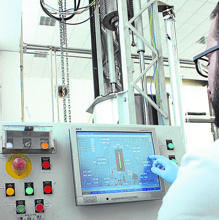As the OMS spreads, more than 200 known lockdowns can be transmitted through food. Increased risk in times of globalization and increased exports and a real challenge for innovation, after centuries of traditional conservation (smoked, salted, cured, etc.) and the milestone that was, in 1864, the discovery of pasteurization .
The present has passed so that the day of innovation has been implemented, as is the case of the applications of the ultraviolet pulse, encapsulation, ionizing radiation, ultrasound, etc. And the use of cold plasma, directly on the product, or through 'plasma activated water'.
This summer, the most outstanding contribution corresponds to the application of high pressures, as Daniel Martínez Maqueda, doctor-researcher in Food Science and Technology at Imidra, Center for Gastronomic Innovation of the Community of Madrid, comments: "It has been For more than a decade, the science of stable food supply forms the basis for new non-thermal preservation treatments (with a remarkable capacity to preserve the sensory and nutritional properties of products).
Techniques such as the application of high hydrostatic pressures, irradiation, ultrasound or high intensity electrical pulses should be highlighted”.
 The CNTA is one of the centers in the study of high pressure
The CNTA is one of the centers in the study of high pressure
As Silvia García de la Torre, head of R&D Business Development at CNTA, says: “These technologies can help improve different phases of the food chain, such as the management of food waste. From the cultivation and raising of animals to the consumption of food, to a large amount of waste from a product that does not conform and/or whose characteristics are altered due to the effect of organisms that cause diseases or that worsen their quality (rottenness, bad) odors , strange flavors, etc.). The specialist points out that "it is estimated that around 88 million tons of food waste are produced annually in the EU, an economic loss of 143.000 million euros in the supply chain... which could be reduced with adequate conservation."
First of all, security
This action is to guarantee safety without undermining quality and increase shelf life, based mainly, at the moment, on less solid, viscous, 'opaque' foods, as the researchers call them. And with notable advances on packaging, as pointed out by the Ainia technology center: "Active packaging with antimicrobials and bacteriophages improves the shelf life of meat products, a breeding ground for the growth of microorganisms, especially on its surface, as bacteria, yeasts and molds that can be pathogenic”.
Innovation, in this case, involves the incorporation of protection additives to the packaging (instead of being applied to the food itself), of different types: "Active substances with antimicrobial properties such as ethanol, carbon dioxide, silver ions or antibiotics, and others of a more natural origin such as essential oils, plant extracts or some spices”.
Ethyl Lauroyl Arginate (LAE), for example, is one of the star components, a molecule capable of being hydrolyzed by common metabolic pathways that increase safety in the food chain. And so it is with another of the assets tested at Ainia, the salmonella bacteriophage, another to fight against possible health risks, as is the case with research into the very composition of the packaging, to mitigate the effects of light and oxygen.
Competitiveness
In this case of high hydrostatic pressure, such as Martínez Maqueda, “products such as juices, smoothies or gazpachos, marketed cold without pasteurizing, with organoleptic properties and nutritional value indistinguishable from fresh. Its application to processed meat products is another of the rising trends, achieving greater microbiological safety with more respected formulations”.
This technology, as Carole Tonello, Director of Business Development at Hiperbaric, points out, was invented 30 years ago in Japan (in fact, Tonello wrote his doctoral thesis on this incipient advance), but now its agri-food application is being promoted. In fact, Hiperbaric has established itself as an international reference (it applies 95% of this technology to food treatment), with growth estimates of 75% in the next five years. A business model that, as highlighted by the Burgos-based company, "responds to the five key consumer trends that demand 'ready-to-eat' products, better preserved and longer lasting, more sustainable and safer".
According to Hiperbaric estimates, the industries that use cold pressure in Spain are, above all, juices and beverages (25%), avocado products, fruits and vegetables (25%), meat products (19%), in addition to, among Others, fish and shellfish (8%), prepared dishes (6%) and dairy products, baby food and animals (3%). Tonello highlights how "we take advantage of exerting pressure first on the liquid, not on the container with the liquid, and in large quantities", A 'massacre' for unwanted microorganisms without the need to apply heat and with a guarantee of flavour, color and security.
A technology that has the confidence of European projects such as Bevstream and that faces the challenge of moving forward to equate costs to traditional means, as Tonello points out: "Costs will be balanced, but, in any case, we are talking about something fundamental, the health, since risks are eliminated and the use of additives is not necessary. And not only for humans, but also for pets, which consume a large part of their diet through ultra-processed, dried, packaged products.